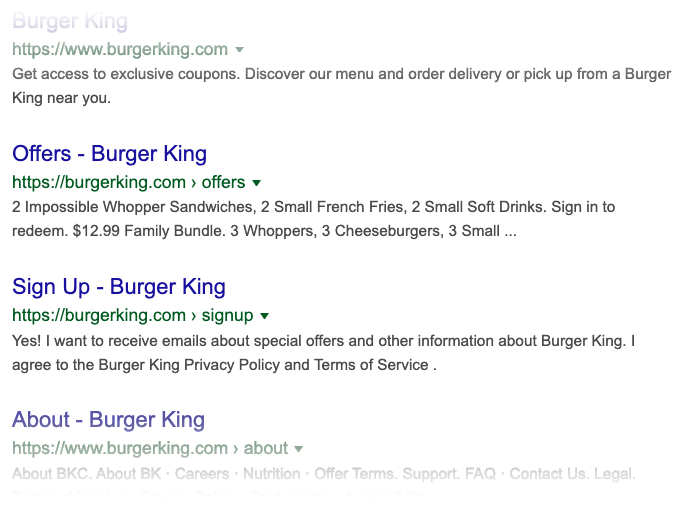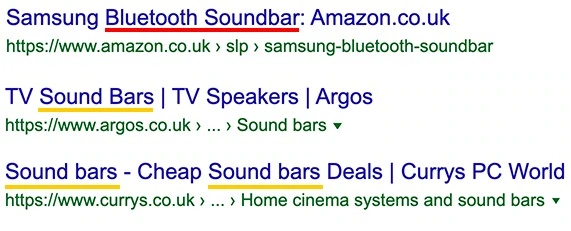Being found on Google and other search engines can be vital for your business; it’s imperative that those looking for your goods or services can find you easily online. Your information needs to be succinct, compelling, and without grammatical errors, whilst including keywords and accurate descriptions.
So how can you achieve this? Of all the SEO strategies out there, this is one of the easiest to implement. We’re going to look in more detail at meta titles, meta descriptions, and the URL / slug. The below image shows the anatomy of a search result in Google.
Search engines crawl the pages that make up your site and analyse the information within them. This information is used to create the index which is displayed when you search for something.
The content displayed from search queries need to address the query based on the type of search that was carried out. With most searches being informational, navigational, or transactional – it is important to focus on the end user or customer when writing titles and descriptions. These are the starting point of your customer journey, and are what will get visitors to click through to your website.
What does your site currently look like in Google?
If you’re not sure where to start, you can see how your current website views in Google. Simply type in ‘site:yourwebsite.com’ in Google and how the search results display for your website. Is it enticing, and – if you were a customer – would you be compelled to click through? Does your site look interesting and informative? Below we can see the opening results of ‘burgerking.com‘.
How to write Meta Titles
Meta titles are the title of a web page that relate to the content of your webpage. These titles contribute as a ranking factor in search engine results. When someone searches for something online they will be looking with specific words and phrases e.g. accountant in Northampton, or shoe shops in Milton Keynes. Therefore, your website will need to have accurate, and true, meta titles.
Think carefully about your meta title, consider your primary keyword such as your key product or service; secondary keyword i.e. another key service or product, and your brand name. Make your information stand out, as you will be up against numerous competitors. Ensure it is accurate and true, but also specific enough to encourage visitors to click through.
When we are skimming through the search results, it’s important that we see the keywords relevant to our initial query. See the results of a search for ‘bluetooth soundbar’. In my opinion the “Samsung Bluetooth Soundbar” result appeals to me the most as it has perfectly matched my search query and caught my attention. Google has also placed this higher than the others – potentially because of the higher relevance to the initial search. Exact match is highlighted in red, whereas a partial match is in yellow.
Duplicate meta titles on your site will have a negative impact on your search result ranking. You should ensure your content is relevant and each page has unique, accurate, meta titles that reflect the content of the page it is linking to. Therefore if you’re a service company, each service can have its own page – as can each sub-service. If you’re selling shoes you could have separate pages for men’s shoes, women’s shoes, as well as each of the products falling in each category.
This changes frequently, however meta titles have a character limit of circa 60 characters, or 568 pixels. This means that you have to be wise with your words when optimising meta titles, using only important keywords in title tags.
Write a great Meta description
This is a more detailed description of the product or service, that relates to the meta title, and the page you are promoting. To use the example above, if you’re an accountant in Northampton your description may include: Small business – tax returns, bookkeeping, VAT returns, and accounting software. If you’re a shoe shop, it may include: Women’s shoes – leather boots, trainers, flip flops.
These meta descriptions provide a visible snapshot in the search results to show someone what your page is offering so they can evaluate if it matches their requirements. If it is then they are likely to click through on to the page to find out more. When writing these consider what your unique selling point is. How can you convey concisely what’s different about you and your business to encourage someone to click?
This example demonstrates how three keywords can naturally be incorporated into the meta description. ‘Professional headshot’, ‘portrait photography’ both appear in the description and are partially included in the title and a fusion keyword appears as the slug. In addition, a bonus keyword of ‘photography services’, is also included. This gives a clear understanding of what the page will include. You can use this method to improve your meta descriptions.
Good meta descriptions need to be unique to each page of your website. Use keywords and keyword phrases that potential customers may be using in search terms to increase the relevancy, but crucially, although you want your website to be ranked in search results, ALWAYS write for the customer. Does your sentence make sense, is everything spelt correctly, does your target market understand abbreviations? Is your copy interesting, does it encourage a reader to act?
If your information is accurate and delivers visitors to your site, who stay on your site and interact, search engines can identify this and detect that the information provided to the search query is relevant. Often this will mean that your site is rewarded for providing a good user experience.
If you don’t write a meta description the search engine will pull the first line or two from that page for you. That’s fine, if your opening copy is compelling, and the page reflects what you do; but not so great if you have a list of staff names; or a long and complicated description.
Meta descriptions have a limit of circa 160 characters, or 940 pixels, so ensure your information is succinct, accurate, and reflective of your product or service. If your meta description is too long, the search result will show ellipsis (…) which may then miss your key selling point. Incorporating keywords into meta descriptions does not directly impact search engines – it does improve the relevancy and is likely to improve the click through rate.
Meta keywords are an old method of telling Google what your page should rank for. These methods were frequently abused and Google announced that they had decided to stop using these as a ranking factor in 2009 after updating its ranking algorithm.
One final point to mention, don’t use double quotation marks (“) in your meta titles or meta descriptions – Google will cut it off at this point.
URL / slug
This is how the page appears in the browser bar. For example the homepage of your website may appear as: yourhomepage.co.uk, but your page on women’s shoes may appear with a suffix i.e.: yourhomepage.co.uk/womens-shoes. This suffix is your slug and relates to the content of that page.
In the above example, the slug is carrots-and-root-vegetables inside the categories of fresh-food and fresh-vegetables. This gives me confidence that the site I am looking at it is structured and has returned a result that I can use.
If your page has a long title description e.g. twenty-tips-on-how-to-get-your-website-to-rank-higher-in-2020, it can be shortened to: rank-website-higher-2020.
As with your meta title and meta description, keep this slug relevant. Use keywords if appropriate and make sure it’s short and to the point. This helps to make it easier to read for a visitor to the site, and can help with them remembering the page link.
When will my updates show in SERP?
There is no definitive answer to this question as each site varies in how valuable Google sees it, and how often it will allocate resources to crawl the site for updates. Search engines use their own algorithms to reference websites and content. Updates can often be seen within 24 – 48 hours but can sometimes take much longer than this. The search engine will also be using other factors to help rank the page, including relevance in search results, clicks, number of visitors etc.
You can request Google to recrawl your website, and they may do this within a few hours, or within a few weeks.
Why doesn’t Google show my meta title?
On occasions Google will appear to have a mind of its own, however, don’t worry, it’s actually trying to give the best result to its user. If you ensure your title, description, and copy is written focussing on the user or customer then you will have more success, even if Google doesn’t display it how you expect.
If Google does find more relevant text to the search query from within the page, then it may override your custom meta title and revert to something it considers more valuable to match that person’s search. It may also take your page title if you have not written a custom meta title.
A search engine may omit your title from the search results if it contains too many keywords. This is called keyword stuffing, and can result in a poor user experience, as it tends to be written for search engines rather than website visitors. This is something best avoided. For titles, we recommend a maximum of two keywords to be included, whereas descriptions can contain two or three.
6 Tips to Write Great Meta Titles and Descriptions
1) Get the length correct
2) Make it relevant to the search query
3) Include keywords - but don’t keyword stuff
4) Write it for your intended audience
5) Make each one unique
6) Your title tag is your call to action - make it work for you
Do you still have questions?
Please give us a call on 01280 734176 and we’ll be happy to help.



